Looking back at the crypto market over the past year, many participants were surprised. At the end of 2022, the market fell into despair after the FTX thunderstorm. With the release of leverage and panic, it began to bottom out. At that time, everyone thought it was just a rebound from the deep bear market. They did not expect that Bitcoin could break through the 50,000 mark in just one year, and many altcoins would rebound from the bottom ten or even dozens of times.
I am afraid that devout crypto believers would not have imagined that the market rebound would be so violent.
In this process, the market has also given birth to many hot topics and tracks. The outbreak of hot topics has provided the market with rising momentum. Such as Inscription, RWA, Bitcoin ETF, Meme, Modularity, etc. Especially since the end of last year, Mingwen has taken over and has become the most popular DePIN. If Mingwen is the carnival of Asian retail investors, then DePIN is the "darling" of European and American capital.
According to data from Coingecko, as of February 2024, the size of liquid assets in the DePIN sector has exceeded US$16 billion, and the Messari Report It is predicted that the market size of DePIN is expected to reach US$3.5 trillion in 2028.
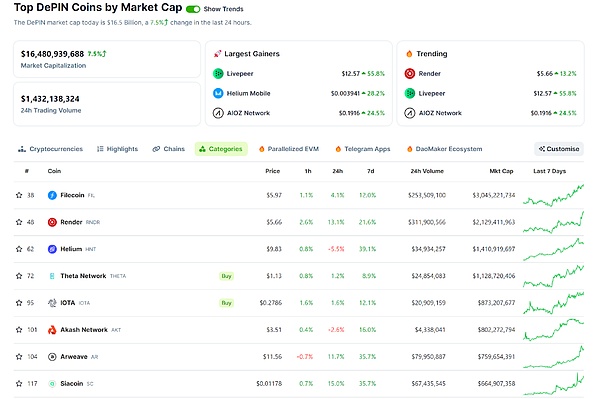
Information comes from Coingecko, data as of 2024.2
DePIN is the abbreviation of Decentralized Physical Infrastructure Networks. Simply put, DePIN is based on the blockchain and uses Token incentives to allow users to participate in network construction and large-scale deployment of hardware, thereby forming an infrastructure network.
Many people will have questions when they see this. Aren’t these concepts being worked on a long time ago? Such as Filecoin, Helium, Arweave, Theta, etc., is this another packaging concept that is just a waste of time? Some people even compared the IMO (Initial Mining Machine Offering) concept a few years ago and CX projects such as Pi with the current DePIN, questioning that DePIN is a so-called packaging concept to sell mining machines.
Opportunities of the DePIN track
Compared to the Inscription track, which is driven from the bottom up by the consensus of retail investors, the construction of infrastructure networks is usually top-down. The production and participation of hardware means that the DePIN project requires sufficient preliminary work. Capital support is required to ensure that hardware can be spread more widely to establish strong network coverage, which requires a large amount of capital and long-term investment.
Compared with traditional infrastructure providers, native Web3 companies usually do not have so much money for continuous construction. In the early days, the team could only attract users to participate in the speculation and obtain funds through "issuing coins" and "selling mining machines", and then used the funds to increase the currency price.
If it is in a bull market cycle, this method can be a positive cycle. Mining machines and currency prices continue to rise, and participants have higher profits. Give back and attract more people to participate. However, the crypto market changes rapidly. In the last bull market, many project parties encountered a bear market before selling much. They were faced with the dilemma of being left with a pile of chips and mining machines and unable to ship without liquidity.
Many participants are also faced with the equipment in their hands digging every day, not to mention the power consumption and can only produce a bunch of useless " integral". Therefore, most users who participated in such projects before the last bull market did not receive good returns, and even those who participated late lost all their money. This has also caused many "experienced people" to sneer at DePIN and define it as a Ponzi scheme.
There is an old saying that "one step ahead is a pioneer, three steps ahead is a martyr". There is no doubt that there is no capital support, no hematopoietic ability, and almost zero infrastructure. They only rely on token speculation to sustain the project and then encounter a bear market. These project parties and participants have become "martyrs."
I think the popularity of DePIN this time is mainly due to two points, the improvement of fundamentals and the attention of capital. The bottom line is, now is the right time.
DePIN has gradually started to have practical applications from "speculating on the concept of selling mining machines", and its value has gradually been recognized by the market. The most representative project, Helium, has successfully transformed and is deeply integrated with Solana. Helium Mobile, which started from scratch, recently launched a $20 unlimited call data package in the United States that has been highly praised. The decentralized GPU rendering network RNDR has also established cooperation with giants such as Apple, Microsoft, Google, Nvidia and Disney. Improving fundamentals mean the track is no longer just a castle in the air.
The hype of any new technology is inseparable from the promotion of capital. Before 2022, there is no overall definition of the entire DePIN track, and the classification of projects is also decentralized Internet of Things, decentralized storage, decentralized computing, etc. It was not until the end of 2022 that Messari formally proposed the concept of DePIN through voting, and then judged in early 2023 that DePIN would be one of the most noteworthy tracks in the encryption field in the next ten years. The entry of capital has enabled DePIN to develop rapidly. Currently, there are more than 600 DePIN projects according to statistics. As the market warms up, venture capital investors have become active again, and there are countless new investments and financings in the DePIN field.
Not to mention blockchain, even the Internet of Things platform, big data, cloud computing, AI, VR, etc. that have been used on a large scale. Technologies such as AR have actually experienced repeated cycles of hype and bubble bursting. Therefore, we ordinary investors should not be too biased against a thing because of the past.
How to choose and participate in the DePIN project?
Even though the entire sector has seen a large increase now, the entire DePIN track is still in its early stages, and the development of DePIN is It is top-down and requires continuous in-depth development by the project team. It will hardly dare to get on the bus like Meme, let alone a myth of "10,000-fold increase" that will appear out of nowhere.
There are two ways to implement investment. One is short-term speculation, taking advantage of the current hot market sentiment and trend to buy some DePIN project tokens. For example, FIL, HNT, RNDR, AR, AKT, etc. are listed on major exchanges and are sector leaders with good liquidity. This method does not require the purchase of equipment, does not need to consider the payback cycle, and the stop-profit and stop-loss are more flexible. The disadvantage is that it is easy to go short.
If you are optimistic about the potential of the DePIN track, you think this track may be a big narrative like DeFi and public chains. , then get deeply involved in some potential new projects with good fundamentals, continue to invest in construction, ignore short-term fluctuations, and gain growth profits.
This disadvantage is that it takes a long time and energy, and if you choose improperly, the project will die and there will be no harvest. Therefore, how to choose among hundreds of projects is a very important ability.
We can pursue the principle of borrowing and let the agency help us screen one first. Many institutions and rating media will publish some lists for investors' reference. These lists will screen out some high-quality or well-known projects in the same track. We only need to analyze a few projects in the list, and finally choose the best 1-2 projects in each section to participate, thus avoiding the need to find a needle in a haystack.
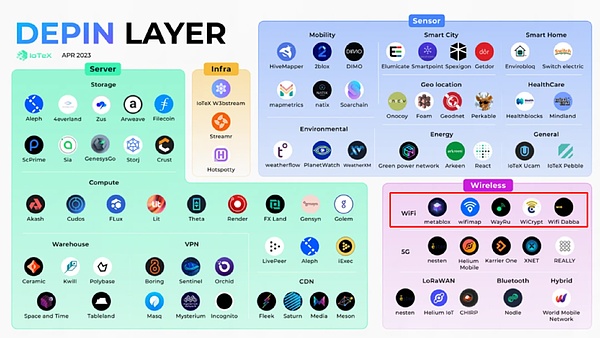
Taking Wireless as an example, the WiFi section lists a total of 5 projects, namely Metablox, Wifimap, Wayru, Wicrypt, and Wifi Dabba. (Data based on 2023/12)

Wayru, Wicrypt, and Wifi Dabba mainly provide wireless networks in developing regions (such as Latin America and India). The community size is small and the infrastructure construction is relatively slow.
WiFi Map has the largest number of users, but its function is similar to the overseas version of 3.60 Master Key. It has no hardware device support and its main profit methods are subscriptions and advertising. , the team’s Web3 operation experience is weak.
The most promising one is Metablox, which is committed to building a global WiFi open roaming network and empowering users with decentralization. The ability of Identifiers (DIDs) and corresponding Verifiable Credentials (VCs) to seamlessly switch between public WiFi networks, providing enterprise-grade WiFi roaming to the public.
The main members of the team are located in Canada. The seed round was led by Synergis, a well-known North American institution, with participation from Depinlabs, Collab and other institutions.
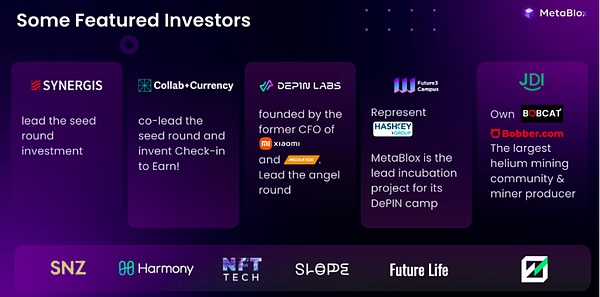
Metablox is one of the 11 company providers of OpenRoaming's Identity Provider (IDP) of the Wireless Broadband Alliance (WBA), and it is also the only Web3 company among them.
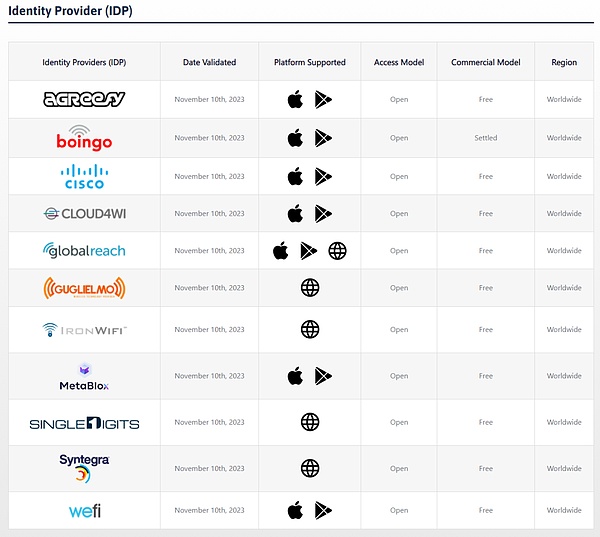
Information comes from WBA OpenRoaming official website
Thanks to the innovative model of Web3, Metablox has deployed 70,000+ self-built WiFi network nodes in 100+ countries around the world in just two years through user participation. According to data from the DePINscan official website, the number of nodes ranks The DePIN circuit ranks second in the world.
Users can also share and use more than 3 million deployed on land, ships, and aircraft by Boingo, Cisco, Global Reach and other companies in the OpenRoaming Alliance. A WiFi node enables convenient and secure WiFi connections around the world, enabling freedom of network roaming.
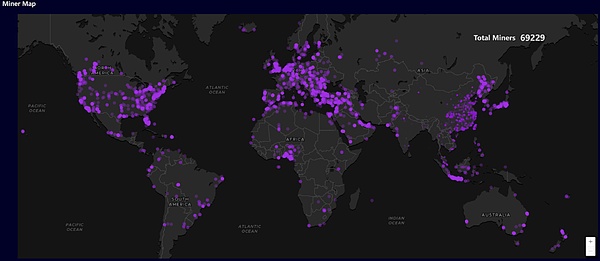
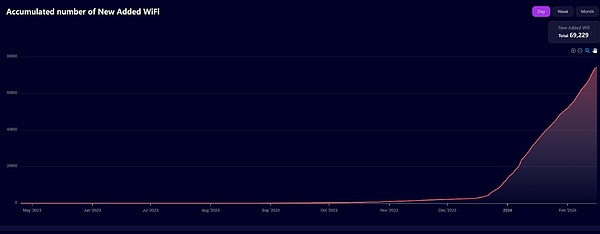
Information comes from Metablox, data as of 2024.2
The entire Wireless track, other competitors Either they live in a corner and only open up some areas, or they are "midway monks" hoping to gain some popularity with DePIN. Metablox can be regarded as a pure-blooded Web3 project. And through its own excellent strength and strong partners, it has rapidly expanded and completed the deployment of infrastructure to make the products truly usable.
Metablox Token Economics
In the field of DePIN and even the entire encryption market, the most difficult challenge is the impact of token price fluctuations. Unlike traditional companies, which are mostly allowed to go public after they develop to a certain scale and have good profit prospects, DePIN projects often use tokens as incentives in the early stages to encourage participating users and operators to invest in deploying related hardware.
This approach can provide participants with initial financial compensation and a small return on investment, motivating them to use the network before it is approved by users. Charges continue to operate until they become self-sustaining. As the network develops and scales, the project is expected to achieve economies of scale.
However, the price fluctuation of the token itself may become a factor that hinders users from participating in the DePIN project. The main driver of user participation is profitability: although the DePIN project presents a clear value proposition, the market performance of its native token remains a key factor in attracting and retaining users.
Since participants receive the project’s native tokens as rewards, price instability may directly affect their profits. Rising token prices tend to make it easier to attract users interested in rising market trends. Conversely, during a market downturn, a decline in token value and profitability may prompt some participants to leave. This situation is particularly severe for those tokens with lower market capitalization and poor liquidity, which may trigger a series of death spirals, which has occurred in many previous DeFi (including GameFi, DePIN) projects.
Tokens are used as a medium to pay network service fees, and their price fluctuations will also have an impact on users. If the token price rises sharply and the service fees are not adjusted accordingly, that is, the threshold is too high, which may prevent potential users from participating. Therefore, having a robust token economic system and operating model is critical to mitigating the impact of price fluctuations.
MetaBlox’s token economic model contains the following three elements:
mPoints points: In MetaBlox’s token system, mPoints play a core role. Users can participate in network construction, Check-in-to- Earn: Earn points by punching in, or purchase them directly or redeem them from partners with MetaBlox. Subsequent mPoints can also be exchanged for governance tokens through staking, destruction, etc.
Governance tokens: Users can obtain governance tokens through multiple channels, such as staking, participating in activities, or receiving airdrops. These tokens are mainly used to verify network services, participate in community governance, and obtain operating permissions.
MetaBlox NFT: NFT issued by the MetaBlox Foundation, which can be bound to specific mining equipment. Users holding NFT can obtain mPoints by staking NFT, and NFT also provides its holders with a special identity within the community.
There is a complex and multi-level exchange mechanism between these tokens: mPoints can be exchanged for governance tokens through pledge and destruction, while MetaBlox NFTs can be rewarded with mPoints through staking. This design constitutes a complex and closely connected token ecosystem.
Named airdrop & participation method
Currently, MetaBlox has not issued coins yet and is in its early stages. And the official announcement of the airdrop is free.

Go to the app store to get Metablox. Apple requires an overseas ID, and Android requires the Google Store.
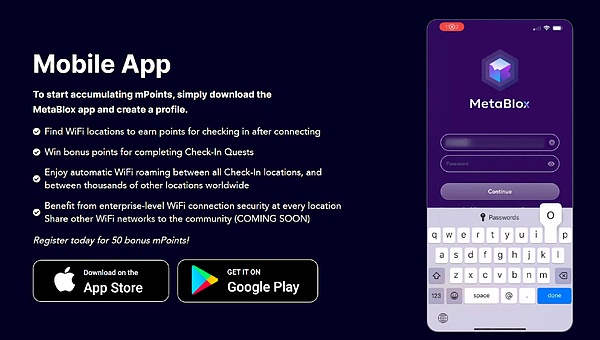
Follow the process to add WiFi to get mPoints rewards, and you can get mPoints by signing in every day.
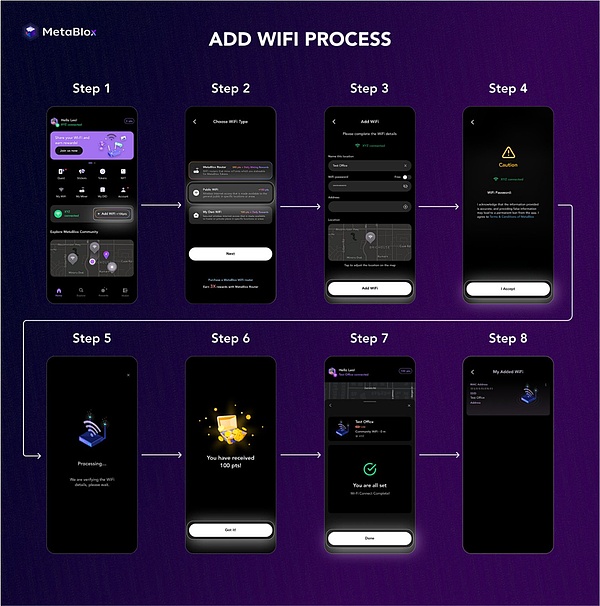
DePIN's use of a distributed transparent system to improve infrastructure scalability and operational efficiency is in line with the principles of the cryptocurrency industry. Such projects apply token economics to pool crowdsourced resources such as storage capacity and computing power without having to invest large amounts of initial capital. It has potential application scenarios in various industries, indicating a huge potential market .
In the process of its popularization, there are still many challenges such as product experience, moat establishment, regulatory compliance, and talent shortage. DePIN cannot fully replace centralized networks in the short term, so it will likely coexist with traditional infrastructure providers. In the long term, the emergence of DePIN will have a profound impact on the market, whether it is from the perspective of lowering barriers to entry, innovation, or utilizing idle resources and money flow.
For us ordinary investors, the best choice is to follow the trend when the trend comes, put down our prejudices and participate boldly. When the market is overheated, stay rational and get out in time.
 JinseFinance
JinseFinance
 JinseFinance
JinseFinance JinseFinance
JinseFinance JinseFinance
JinseFinance JinseFinance
JinseFinance JinseFinance
JinseFinance JinseFinance
JinseFinance JinseFinance
JinseFinance JinseFinance
JinseFinance Coinlive
Coinlive  CryptoSlate
CryptoSlate